C-Type Cruisers (CL 1915-1922)
Back to
Royal Commonwealth Ships
List
The C type cruisers actually comprised 5 different classes with a total of 32
ships.
Caroline Class (6 ships)
Cambrian Class (6 ships)
Centaur Class (6 ships)
Caledon class (4 ships)
Ceres Class (10 ships)

The classes followed each other with slight improvements between classes but not
enough to slow down production. Differences in armament started with the
Caroline's with their single 6" fore and aft and single 4" down each broadside,
almost clones of the preceding Arethusa class, through to the five 6" inline
mountings of the Ceres class. The 4,000 ton cruiser design evolved into ships that were thought good
enough to be used everywhere in the Second World War as much as they had in the
First.
The Carolines:

For its time, the Caroline held the building record of just 11 months.
The Cleopatra and Comus were the headline acts for WW1 with the Cleopatra
ramming and sinking the destroyer G.194 and the Comus catching and sinking the
raider Greif.

By the end of the war the Carolines had the aft 4" replaced with a third 6" and
the 4" beside the bridge were replaced with single 2pd AA quick firing guns. The
armoured conning tower was removed and the fore 6" mounting moved backwards to
help with seakeeping, the pole mast replaced with a tripod
similar to the Arethusa class. By 1930 the single 3" was removed and replaced
with another 2pd AA gun. The last four low angle 4" were replaced with single 4"
AA guns.
.png)
The Caroline's, like the other early C-Types, had a hard war. Being the newest
cruisers available at the crux of the sea war in 1915-16, meant they were the
van of the fleet as the lead scouts, and leading the Fleets destroyer squadrons.
Always doing things at maximum revs. Once 1930 had come and gone the Caroline's
were reduced in service as the modern Light Cruisers of the Leander and Town
types came into service. Postings to far away squadrons and long patrol duties
were to be their lot.
.png)
Carysfort was Flagship of the Far East Squadron based on Hong Kong with the
Cordelia when the Japanese attacked all over the Pacific. Both ships escaped
Hong Kong and were ordered first to Singapore and then to Australia carrying all
the bullion from the Hong Kong banks and picking up the same from Singapore.
Both ships came under air attack in the narrows between the
Philippines and Vietnam, but their routing had meant that the ships were
passing through the narrows as much in darkness as possible, so by the time a
second strike could have been organised, it was dark, and the ships were
hundreds of miles further south after daybreak. From Singapore the ships passed
through the Sunda Strait, to Darwin, where the bullion was offloaded and sent by
rail to be stored in Canberra. The ships were ordered back to Singapore with
rare spares and supplies for the aircraft operating in Malaya. Both ships were
under air attack with the rest of the ships in Singapore and received near miss
and shrapnel damage. Both ships were filled with woman and children from base
personnel and sailed with two destroyers as escort. All ships leaving Singapore
were being heavily attacked by Japanese air units, but the Naval units were less
prone to damage having heavy AA armaments with which to fight back. From Darwin
the Carysfort, Cordelia, Viceroy, and Viscount were sent to join the ABDA
squadron based on Surabaya, Java. The four ships had barely reached Surabaya and
were in the process of refueling when the news of the decimation of the ABDA
squadron was received. The ships were sent west to find and help the survivors
back to Surabaya. Perth, Houston and Exeter are too big to go through the
straits to the east and are sent west to try to escape through the Sunda Strait.
None make it through, all are sunk. The four ships are joined with the
destroyers Express and Excalibur, with Commodore Langsford in command, and are
ordered to head east for the Lombok Strait. The Japanese have had time to land
troops on Lombok but not on Bali which is still Japanese free. The Japanese have
a force of two cruisers and four destroyers guarding the strait and supporting
the troops on Lombok. But those Japanese ships also have to guard the strait
between Lombok and Sumbawa, the Alas strait. The Nagara and two destroyers are
on high alert during the hours of darkness, and each ship takes turns to light
up its searchlights to illuminate the waters of the strait. The six Royal Navy
ships can see this happening but are not aware of the composition of the enemy
forces. The Commodore ordered his ships into single file and increased speed to
25 knots, there was only one way out and the RN ships needed to be far south of
the strait when daylight found them again as the Japanese aircraft would be
looking for them once they got through the strait. Lights stream from port but
the RN ships are just outside the coverage. All the RN crews are in readiness
with guns and torpedoes pointed outboard. They all know that in about ten
minutes they will be fighting for their lives, adrenaline levels are high.
Lights start to flare to starboard and before the full beam strikes the two RN
cruisers open fire with all guns that will bear. Within minutes all nine ships
are firing at each other, all launch torpedoes, searchlights show up all the
ships in sharp silhouettes, the Japanese destroyer the cruisers opened fire on
burst into flames as the 6" shells burst on or around it. That was the only
piece of good fortune the British squadron had. The Allied navies were still in
the process of learning just how deadly the Japanese 24" Long Lance torpedo was.
The Japanese had launched torpedoes as soon as their searchlights had lit up the
British line. Following my leader the squadron started exploding, Cordelia took
two hits, turning out of the line, heeling over and sinking. Viscount and
Viceroy took a torpedo each, but that was enough for them, Viscount broke in
half with one end sinking straight away and the other end washing ashore.
Viceroy rolled to starboard, all power lost and continued firing at the Japanese
ships as the other two destroyers passed, accelerating to catch up to the
Commodore. Half the British ships sunk at one salvo, not a bad return. The
remaining two Japanese ships did not chase after the remaining ships as their
first priority was still to guard the strait. So ended the Battle of Lombok
Strait. Another success to the Japanese. Commodore Langsford's after action
report on the Japanese Long Lance torpedo helped the Allied forces think of ways
to negate its advantages.
Carysfort spent the rest of its war escorting convoys in the Indian Ocean, its
period of excitement was over.
| Displacement |
4,220 tons standard, 4,750 tons full load |
| Length |
446 ft |
| Breadth |
42 ft |
| Draught |
16 ft |
| Machinery |
4 shaft steam turbines, 40,000shp |
| Speed |
29-30 knots |
| Range |
4000 miles at 18 knots |
| Armour |
3" side, 1" deck |
| Armament |
As Completed
2 x 6" (2x1)
8 x 4" (8x1)
1 x 3" AA (1x1)
|
Refitted to 1930
3 x 6" (3x1)
4 x 4" AA (4x1)
3 x 2pd AA (3x1)
|
Refits to 1940-41
3 x 6" (3x1)
4 x 4" AA (4x1)
6 x 2pd (1x4, 2x1)
4 x 20mm (4x1) |
| Torpedoes |
8 x 21" (4x2) |
8 x 21" (4x2) |
8 x 21" (4x2) |
| Complement |
325 |
345 |
360 |
| Notes |
Caroline (1914) Still extant 2017, Belfast, Northern
Ireland.
Carysfort (1915) Scrapped 1945
Cleopatra (1915) Bombed in North Sea by Luftwaffe aircraft 1940. (New
CLA renamed)
Comus (1915) Scrapped 1945
Conquest (1915) Expended as part of Mulberry artificial Harbour 1944.
(towed Constance)
Cordelia (1915) Sunk in Lombok Strait 1942 |
The Cambrians:
.jpg)
The Cambrians followed many of the Carolines features but differed in things
like only having two funnels (carried forward on all the following C & D types),
and just as importantly the last half of the class introduced geared turbines to
the Royal Navy cruiser lines. The armament still featured the mixed 6" and 4"
guns, but the Cambrians had three 6" for its original armament and thus less low
angle 4".

By the end of WW1 the armoured conning tower had been removed and the bridge
enlarged and the fore 6" moved backwards which aided seakeeping. A director for
the 6" was added to the top of the foretop. The single 4" had been removed and
replaced with 3" and 2pd AA guns, the 3" later being replaced with a quad 2pd AA
mounting. Like the Arethusa and Caroline Class ships, the Cambrian class ships
were very much second rate cruisers by the opening of World War Two. The only
thing that saved them from the breakers yards during the mid 1930's was the
abrogation of the Naval Treaties by Japan and the rearmament of the Germanic
States. Cruisers on the open sea lanes along which Britains lifeblood of
supplies flowed were an absolute necessity and these ships were exceptionally
useful.
.png)
The central 6" was replaced with a twin 4" to enhance the AA battery in 1940.
Two of the class were sent to the Eastern Mediterranean from their posts in the
Indian Ocean, and were heavily engaged in that theater of war. Calliope and
Champion were both lost on this duty, Calliope being bombed during the retreat
from Crete with hundreds of survivors aboard, while the Champion was torpedoed
by MAS boats off the coast of Cyrenaica while trying to run supplies into
beleaguered Tobruk. Cambrian was lost, torpedoed by a U-Boat, escorting tankers
out of the West Indies on the Antigua to St Johns route to join more heavily guarded
convoys across the North Atlantic. Constance was heavily damaged, while
returning from the Norwegian campaign, in action against two German destroyers,
and was considered unrepairable. The hulk was eventually expended as part of the
Mullberry artificial harbour as part of D-Day.
| Displacement |
4,250 tons standard, 4,800 tons full load |
| Length |
446 ft |
| Breadth |
43 ft |
| Draught |
16 ft |
| Machinery |
4 shaft steam turbines, 40,000shp |
| Speed |
29-30 knots |
| Range |
4000 miles at 18 knots |
| Armour |
3" side, 1" deck (Calliope & Champion had a 4"
belt) |
| Armament |
As Completed
4 x 6" (4x1)
3 x 4" (3x1)
1 x 3" AA (1x1)
|
Refits to 1940-41
3 x 6" (3x1)
4 x 4" AA (1x2 2x1)
6 x 2pd (1x4, 2x1)
4 x 20mm (4x1) |
| Torpedoes |
8 x 21" (4x2) |
4 x 21" (2x2) |
| Complement |
335 |
370 |
| Notes |
Cambrian (1916) Sunk 1942 off the Bahamas by torpedo
from a U-Boat
Calliope (1915) Sunk 1941 bombed off Crete
Canterbury (1916) discarded 1945, scrapped 1947
Castor (1915) scrapped 1946
Champion (1915) Sunk 1941 off Tobruk, torpedoed by MAS boats.
Constance (1916) expended as part of Mullberry harbour 1944. |
The Centaurs:

The Centaur class were two ships originally ordered for Turkey and taken over by
the RN on the outbreak of war. The Australis Navy built four of the class to a
slightly different layout but same dimensions and armament.

The Centaur class were the RN's first 'superimposed' cruisers with the four 6"
mountings disposed two each fore and aft. All of the class were fitted with
geared turbines and only two shafts. Completed at the end of 1916 for the RN
pair and 1917-18 for the RAN ships, they had fairly quiets wars. The two
non-standard Centaur class were sold on to the Southern African Navy in the
early 1920's. This put them in line for full refurbishment to anti-aircraft
ships, something for which the earlier cruisers were never contemplated. The
single 6" guns were swapped out one-for-one for twin 4". The center 4" gun is
replaced with a quad 2pd AA mounting while the broadside 4" beside the fore
funnel were replaced first with quad 0.5" machine guns then twin 20mm mountings.
the single 2pd AA guns were kept till the single and 20mm Oerlikons were
available. One set of torpedoes was removed to offset the additional radar
added.
.png)
The two southern African Navy Centaurs were tied to escorting the aircraft
carrier Kwazulu
for most of their war. All the Battles around the Falklands Islands the Nairobi
and Rorkes Drift covered the Kwazulu along with the other ships of the Southern
African Fleet.
| Displacement |
4,400 tons std 4,950 tons full load |
| Length |
452 ft |
| Breadth |
43 ft |
| Draught |
15 ft |
| Machinery |
2 shaft geared turbines, 40,000shp |
| Speed |
29-30 knots |
| Range |
4500 miles at 18 knots |
| Armour |
3" side, 1" deck |
| Armament |
As Completed
5 x 6" (4x1)
2 x 3" AA (2x1)
3 x 2pd AA (3x1)
|
Refits to 1941
8 x 4" (4x2)
7 x 2pd (1x4 3x1)
8 x 0.5"mg (2x4)
|
| Torpedoes |
8 x 21" (4x2) |
4 x 21" (2x2) |
| Complement |
330 |
345 |
| Notes |
HMSAS Nairobi (1916 ex Centaur)
HMSAS Rorkes Drift (1916 ex Concord)
HMAS Hamilton (1917)
HMAS Bathurst (1917)
HMAS Townsville (1917)
HMAS Rockhampton (1918) |
The Caledons:

The Caledons were the 'Admiralty' versions of the previous Turkish Centaur type.
The RN designers had acknowledged that the Armstrong Whitworth design for the
Centaur was a vast improvement on the current Admiralty design of the
Caroline/Cambrian types. The major change was the complete replacement of low
angle 4" with an all 6" gunned main armament and two 3" as the AA armament.
Torpedo armament remained the same with four twin mountings.

These ships were actually converted prior to the Centaur type as the Royal Navy
geared up for what it saw as Germanic States rearmament. Even the oldest ships
would be required to be available to assist the war effort.
.png)
The Caledon classes armament placement was experimented with, in Caledon the
quad 2pd mounting was placed in the 'B' position, while Cassandra had the 2pd in
'X' position, Calypso had the 2pd mounting in the more usual 'Q' position.
| Displacement |
4,400 tons std 4,950 tons full load |
| Length |
452 ft |
| Breadth |
43 ft |
| Draught |
15 ft |
| Machinery |
2 shaft geared turbines, 40,000shp |
| Speed |
29-30 knots |
| Range |
4500 miles at 18 knots |
| Armour |
3" side, 1" deck |
| Armament |
As Completed
4 x 6" (4x1)
3 x 4" (3x1)
1 x 3" AA (1x1)
|
Refits to 1941
8 x 4" (4x2)
4 x 2pd (1x4)
12 x 20mm (4x2 4x1)
|
| Torpedoes |
8 x 21" (4x2) |
4 x 21" (2x2) |
| Complement |
334 |
350 |
| Notes |
HMS Caledon Scrapped 1948
HMS Calypso Torpedoed and sunk 1940
HMS Caradoc Mined in Baltic 1918
HMS Cassandra Sunk 1942 Western Mediterranean Sea |
The Ceres Class:

The last of the C type were the ten ships of the Ceres class. Problems with
seakeeping with the early C's led to the abandonment of the armoured conning
tower and the fore 6" mounting being moved back toward the bridge
superstructure. This did alleviate some of the problem but the ships were still
a trifle wet forward. The Caledon hull was taken and fitted with trawler type
bows to help give some extra buoyancy forward.

The ten units of the class were built between 1917 and 1922. They had very quiet
wars as the sea war was virtually at an end by 1917, with only the U-boats
providing a thorn in the side of the British. The ships were some of the cream
of the cruiser squadrons at wars end till the end of the 1920's. Once new
construction started appearing the C type units went to more second class
duties. 1934-35 proved the make or break for the older cruisers still active in
the Commonwealth Fleets, and these ships were saved by the Japanese not
ratifying the last Naval treaty of 1930. The Ceres type being the most modern
were looked at for conversion to anti-aircraft ships before the earlier classes.
Six of the ships had had various conversion work, almost none being the same.
Anything between eight and ten single 4" AA being fitted. Once 1934 and the
advent of the 4" twin MkXVI mounting came about, then the last four had a
uniform armament similar to the three Caledons. These differences in armament
and layouts led to quite different superstructure layouts as well. Most had
their sets of torpedoes removed during their conversion processes.
The next four drawings are all original 'real life' conversions of C class
cruisers drawn by Novice 6-7 years ago. A lot of the parts have been
updated/redrawn since then but the drawings are still of good quality and I have
not tried to improve them as they do provide a good indication of the diversity
of the different armaments fitted to the 'C's.
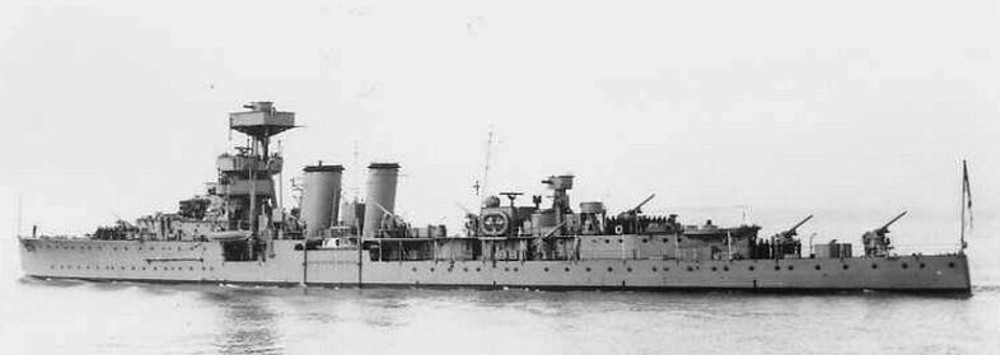

.png)

| Displacement |
4,500 tons std 5,150 tons full load |
| Length |
455 ft |
| Breadth |
44 ft |
| Draught |
15 ft |
| Machinery |
2 shaft geared turbines, 40,000shp |
| Speed |
29-30 knots |
| Range |
4500 miles at 18 knots |
| Armour |
3" side, 1" deck |
| Armament |
Carlisle As Completed
5 x 6" (5x1)
2 x 3" (2x1)
3 x 2pd AA (3x1)
|
Coventry 1936
10 x 4" (10x1)
8 x 2pd (2x4)
8 x 0.5" mg (2x4)
|
Cairo 1939
8 x 4" (4x2)
4 x 2pd (1x4)
8 x 0.5" mg (2x4)
|
Curlew 1943
8 x 4" (4x2)
4 x 40mm STAAG (2x2)
6 x 20mm (2x2 2x1)
|
| Torpedoes |
8 x 21" (4x2) |
nil |
nil |
nil |
| Complement |
330 |
345 |
345 |
350 |
| Notes |
HMS Ceres (1917) Sold 1946
HMS Cardiff (1917) Scrapped 1945
HMS Curlew (1917) Scrapped 1946
HMS Coventry (1918) 1942 Sunk by aircraft
HMS Curacoa (1918) Sunk in collision with RMS Queen Mary
HMS Carlisle (1918) Scrapped 1946
HMS Calcutta (1919) 1941 Sunk by aircraft
HMS Cairo (1919) 1942 Torpedoed
HMS Colombo (1919) Sunk by aircraft 1940
HMS Capetown (1922) Scrapped 1946 |
Lastly are the C class drawings that various people have done for both real and
alternate universe purposes.
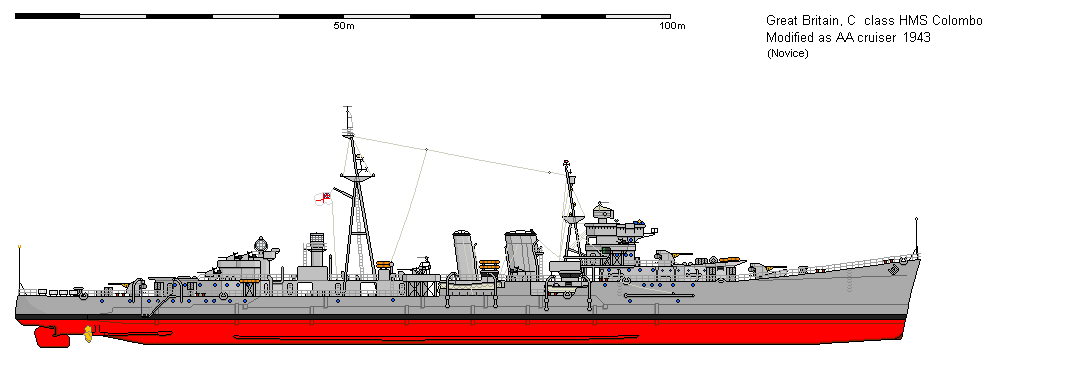
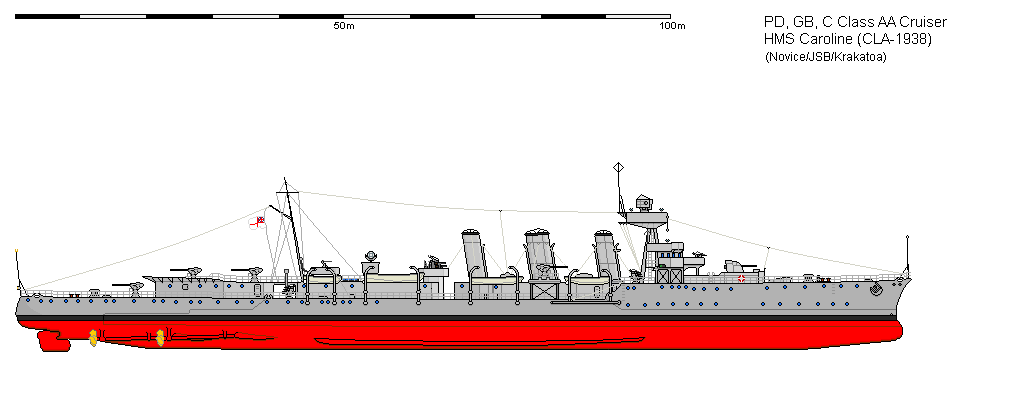
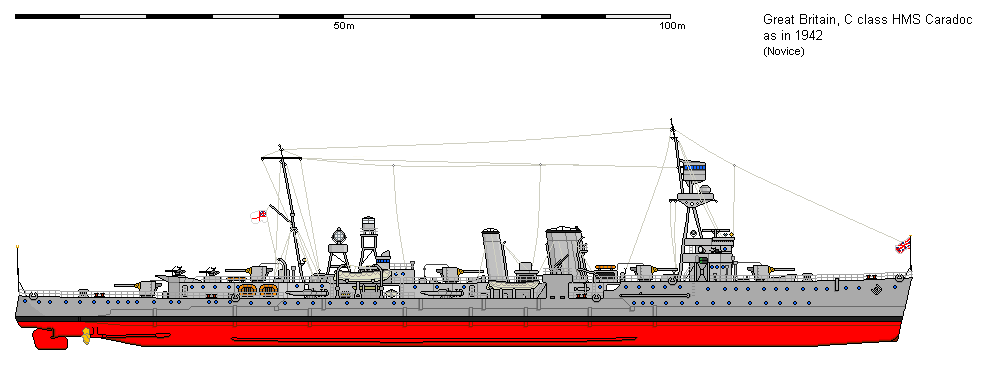
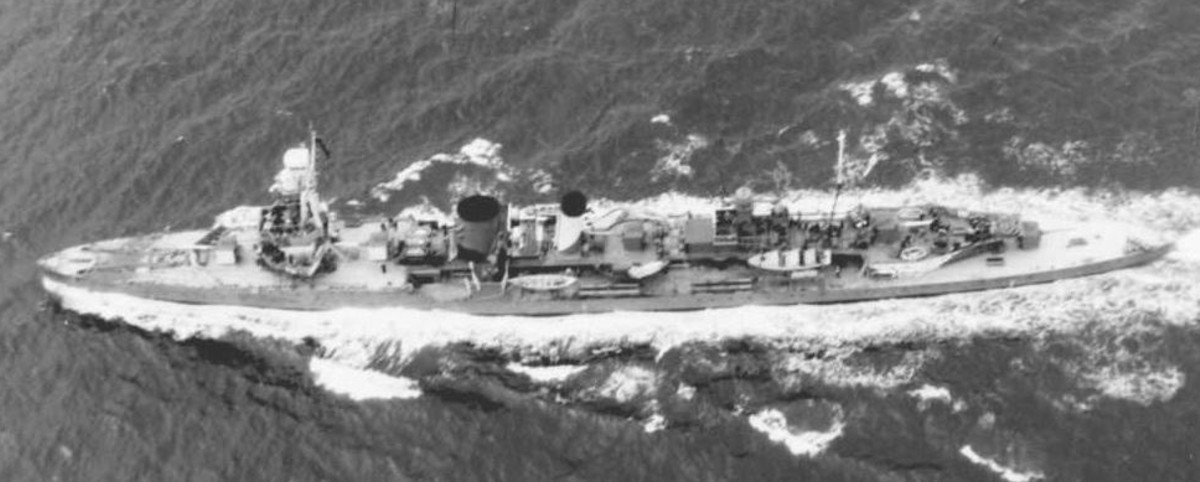
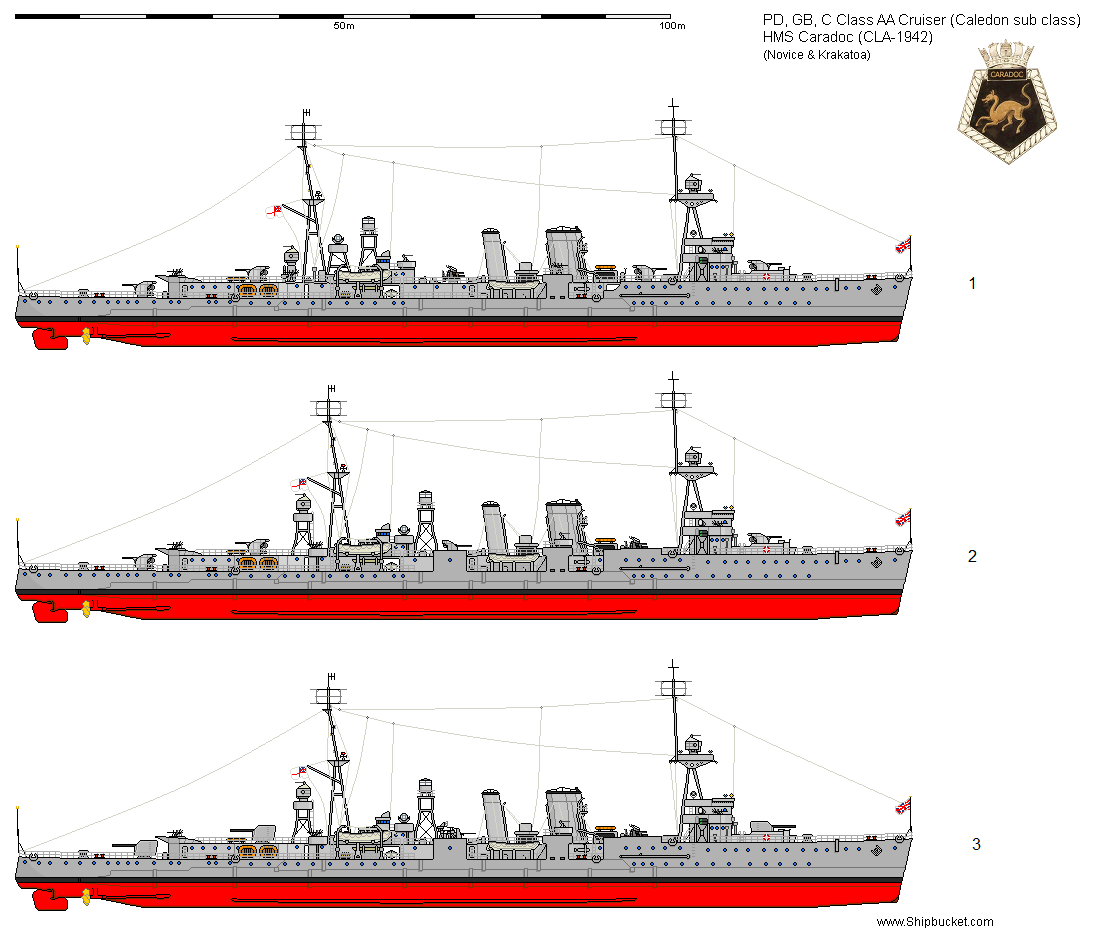
Back to
Royal Commonwealth Ships
List



.png)
.png)
.jpg)

.png)


.png)


.png)



.png)





